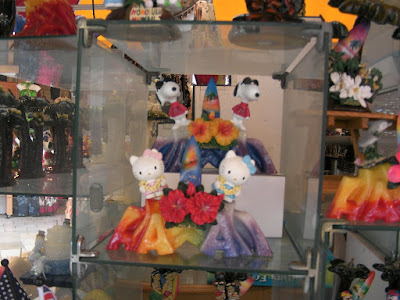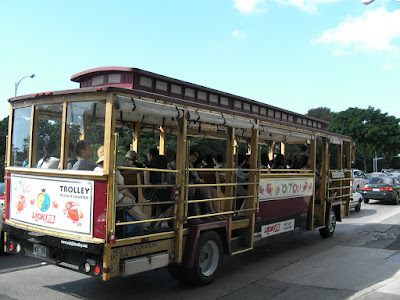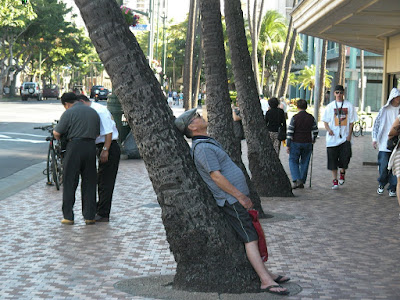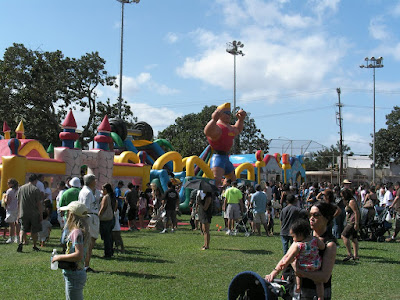 Coconut trees on the beach, against a beautiful blue sky and white fluffy clouds just before sunset... Ahhh paradise!
Coconut trees on the beach, against a beautiful blue sky and white fluffy clouds just before sunset... Ahhh paradise! Waikiki Beach, on the patio of Duke's Bar. The famous Diamondhead is in the background. We also see surfboards and people partying on the beach.
Waikiki Beach, on the patio of Duke's Bar. The famous Diamondhead is in the background. We also see surfboards and people partying on the beach. Beautiful beach in Maui. The winds were strong that day and many surfers were enjoying the waves.
Beautiful beach in Maui. The winds were strong that day and many surfers were enjoying the waves. Sunset in western Maui; photo taken from the tourist-trap city of Lahaina.
Sunset in western Maui; photo taken from the tourist-trap city of Lahaina.Most of my time I spent in Honolulu. Honolulu is a classic example of Japanese globalization a la human dispersal. Many nikkeijin live in Honolulu and even more Japanese tourists visit. I think I heard more Japanese than English during my stay. Here are some shots of Japan in Hawaii:
 Waikiki is filled with designer brand name shops, and thus Japanese tourists flock to these places.
Waikiki is filled with designer brand name shops, and thus Japanese tourists flock to these places. International market. This is the place to go to buy typical tourist junk/trinkets/souvenirs/おみやげ.
International market. This is the place to go to buy typical tourist junk/trinkets/souvenirs/おみやげ. Kitty-chan has become glocalized in Honolulu and made friends with Snoopy.
Kitty-chan has become glocalized in Honolulu and made friends with Snoopy. Japanese tourists are brought from place to place, hotel to shopping center, restaurant to tourist attraction, on these trolleys.
Japanese tourists are brought from place to place, hotel to shopping center, restaurant to tourist attraction, on these trolleys. All of the shopping and other tourist activities are exhausting. Luckily coconut trees are available for relaxation.
All of the shopping and other tourist activities are exhausting. Luckily coconut trees are available for relaxation.Honolulu is also full of Japanese religion. There is a stretch of road on Pali Highway that has numerous and various Japanese temples, shrines, and churches. One example of a Japanese so-called "new religion" that has reached Japan is Tenrikyo. I stayed at a Tenrikyo church in the McCully area and was present for their January monthly service. Tenrikyo is a healing religion that encourages people to live the "Joyous Life." For more information on Tenrikyo, click here.
 Tenrikyo Taiheiyo Church.
Tenrikyo Taiheiyo Church. Dancing at the monthly service. Tenrikyo rituals are complicated and interesting, composed of hand gestures, dance and various instruments.
Dancing at the monthly service. Tenrikyo rituals are complicated and interesting, composed of hand gestures, dance and various instruments. Tradtional dress vs. modern dress. Tenrikyo is very Japanese and has a strict vertical social structure. Major decisions for the Hawaiian churches are made in Japan. Nikkeijin, as Japanese-Americans (stress on the American) often have difficulties with strict Japanese traditions. One small change made in Hawaii is the attire for the service. Many people still wear the traditional kimono, but now one is able to wear black pants and the Tenrikyo happi coat instead.
Tradtional dress vs. modern dress. Tenrikyo is very Japanese and has a strict vertical social structure. Major decisions for the Hawaiian churches are made in Japan. Nikkeijin, as Japanese-Americans (stress on the American) often have difficulties with strict Japanese traditions. One small change made in Hawaii is the attire for the service. Many people still wear the traditional kimono, but now one is able to wear black pants and the Tenrikyo happi coat instead.  The performance instruments are gendered in Tenrikyo. Males play the taiko drum, wooden clappers, small hand cymbals, small hand-held drum, small gong and flute. Females play the shamisen, koto and kokyu.
The performance instruments are gendered in Tenrikyo. Males play the taiko drum, wooden clappers, small hand cymbals, small hand-held drum, small gong and flute. Females play the shamisen, koto and kokyu. After the service is performed, the Church Head Minister gives a sermon. The theme for the January service was "positive change for the new year." The Head Minister explained experience that he and members of the congregation had as messages from God and interpreted their meanings in his lecture.
After the service is performed, the Church Head Minister gives a sermon. The theme for the January service was "positive change for the new year." The Head Minister explained experience that he and members of the congregation had as messages from God and interpreted their meanings in his lecture. The same day as the Taiheiyo Tenrikyo Church Monthly Service there was a Hawaiian-Japanese festival.
 New Year's Ohana Festival in Honolulu, near the Japanese Cultural Center. "Ohana" in Hawaiian means "family."
New Year's Ohana Festival in Honolulu, near the Japanese Cultural Center. "Ohana" in Hawaiian means "family." Rides, games, activities and food for the keiki. "Keiki" in Hawaiian means "children."
Rides, games, activities and food for the keiki. "Keiki" in Hawaiian means "children." Osaka tako balls (たこやき) along with Hawaiian roasted corn.
Osaka tako balls (たこやき) along with Hawaiian roasted corn. One of the highlights of the festival was the mochi (rice cake) pounding demonstration. Who was recruited to do the demonstration?
One of the highlights of the festival was the mochi (rice cake) pounding demonstration. Who was recruited to do the demonstration? Our good friends from the Hawaii Tenrikyo Missionary Headquarters, of course!
Our good friends from the Hawaii Tenrikyo Missionary Headquarters, of course!Here is a short video of the mochi pounding:
Hawaii is a great example of Japanese globalization. "Japan" is a part of the multicultural Hawaii that seems to live in harmony with many other peoples. Perhaps this multicultural harmony can be brought (re-territorialized) to Japan. Many feel that Japan's declining birthrate will require immigration of foreigners to work and support the aging population. Japan's tolerance of foreigners is problematic to say the least. A lesson from Hawaii along with a little aloha might be what Japan needs.

Click here to see more Hawaii photos.

2 comments:
Wow !! wonderful pics. I would like to go hawaii.
Picture indeed paints a thousand words. Even without reading that text, I am already captivated with this essay. I like that blog that I read somewhere.
Post a Comment